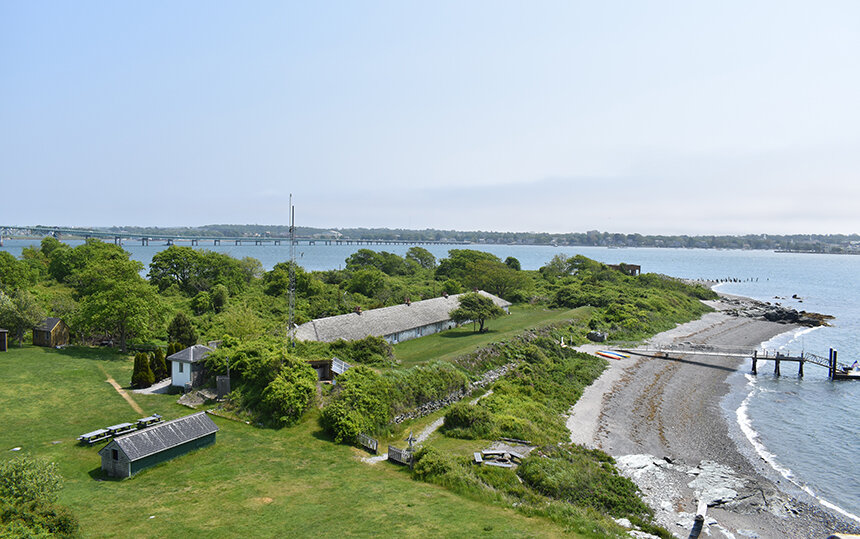For Many On Coast, Climate Crisis Means Rising Insurance Rates
September 28, 2021
The country’s largest flood insurer is changing how it analyzes risk, and it could signal a reckoning for coastal communities.
Next month the National Flood Insurance Program (NFIP) will switch from flood-map-based risk analysis to Risk Rating 2.0: Equity in Action. The new pricing methodology will take into account more flood risk variables and, according to the Federal Emergency Management Agency (FEMA), will result in insurance rates that are more equitable and more agile in the face of the climate crisis.
“Risk Rating 2.0 is not just a minor improvement, but a transformational leap forward,” FEMA spokesperson Rosa Norman said. “Risk Rating 2.0 enables FEMA to set rates that are fairer and ensures rate increases and decreases are both equitable.”
NFIP was established in 1968 to fill the gap left by private insurers that would not cover flooding. It is funded by the federal government — though currently $20 billion in debt, with an additional $16 billion canceled in 2017 to meet claims after hurricanes Harvey, Irma, and Maria.
Since the 1970s, premiums have largely been based on property elevation according to zones on a Flood Insurance Rate Map (FIRM). But this method gives “relatively static measurements,” according to Norman, and leaves room for inequities in pricing and coverage.
“We believe that this is a long-overdue improvement to the way that we identify risk and we price our policies according to that risk, and that’s what insurance is intended to do,” David Maurstad, senior executive of the NFIP and deputy associate administrator for Federal Insurance and Mitigation, said during a Sept. 24 press call.
Risk Rating 2.0 will include more flood risk variables, including frequency, types, distance from water and property characteristics including elevation, and the cost of rebuilding.
“The cost to rebuild, which has not been a part of the way that we looked at it before … led to the inequity that lower-value homes are paying more than they should and higher-value homes are paying less than they should,” Maurstad said. “Moving forward, folks will know what their flood insurance risk is, what the premium costs, and it will be written at a premium level that is either not subsidized by somebody else or they won’t be subsidizing somebody else.”
Risk Rating 2.0 will go into effect Oct. 1 for new policyholders, with a six-month delay — until April 1 — in premium increases for existing policyholders, according to Maurstad.
Risk Rating 2.0 does not include future sea-level rise projections, but it does incorporate data from the U.S. Geological Survey, the National Oceanic and Atmospheric Administration, and the Army Corps of Engineers, which, in practice, should make the rating system adaptive to future conditions.
Premiums are based on the risk at present and will be re-evaluated annually “in order to respond if and when the nature of flood risk changes,” according to Norman. As flood risk increases or decreases in regions across the country, ratings and premiums will adjust.
“It’s very important and [Risk Rating 2.0] will continue to reflect the changes in the climate unlike before in our legacy methodology,” Maurstad said.
Flooding is already the most frequent and expensive natural disaster in the United States, according to FEMA. The U.N.’s Intergovernmental Panel on Climate Change projects precipitation and flooding will increase in the Northeast during the next century, especially in coastal regions dealing with sea-level rise.
According to a 2020 consumer poll by the Insurance Information Institution, 27 percent of homeowners reported having flood insurance, up from 13 percent in 2018. The study noted the findings were higher than estimates made by the NFIP, which “might indicate that consumers think they have flood coverage when they do not.”
FEMA recommends all homeowners and renters invest in flood insurance, as an inch of flooding can cause $25,000 of damage to a home. But only homebuyers in a Special Flood Hazard Area (SFHA) — high-risk flood zones with at least a 25 percent chance of flooding during a 30-year mortgage period, demarcated on FEMA maps with letters A and V — are required by their lender to buy flood insurance.
Nationwide, about 5 million people hold NFIP flood insurance policies with an average premium of $642. The majority of these policyholders live in Florida and Texas, according to FEMA, but there are currently 12,000 held by Rhode Island homeowners and renters.
With the new risk assessment, 54 percent (6,481) of Rhode Island policyholders will see their flood insurance premiums increase. According to FEMA estimates, 486 will see rates rise between $120 and $240 per year, and an additional 389 will see an increase of more than $240 annually. In accordance with a cap set by Congress, most policies will not increase by more than 18 percent each year.
Forty-six percent of Rhode Island policyholders will see an immediate decrease in costs, which, according to Maurstad, will mark the first premium decreases in NFIP history.
With property costs in coastal Rhode Island already high, Melinda Hopkins, state hazard mitigation officer with the Rhode Island Emergency Management Agency (RIEMA), said, “most of the people that are building on the coast or have houses on the coast can afford that flood insurance.”
But insurance affordability becomes a bigger issue for riverine homes, where values might be lower.
Communities can earn discounted NFIP rates for policyholders by participating in the Community Rating System (CRS), a state-administered federal program that incentivizes flood-prevention measures. To join, municipalities have to demonstrate flood-mitigation measures and adhere to state and federal building codes.
The system won’t change with Risk Rating 2.0, but “there are a lot of moving parts,” according to Hopkins, which can make joining a months-long process. Permits have to be up to date and elevation certificates must be in order. The staff time required to pull everything together can act as a barrier to joining, so communities with higher percentages of policyholders are more likely to participate.
Eleven Rhode Island municipalities, including the recently added New Shoreham, currently participate, according to Hopkins, and see discounts of 5-15 percent extended to policyholders. She is working to get more communities involved.
Affordable insurance is something that HousingWorks RI, a center for housing information and research at Roger Williams University, is increasingly looking into, according to program director Brenda Clement.
“It’s an important issue that needs attention,” she said. “Particularly as we see increased areas of examples of urban flooding even as recently as a couple of weeks ago in New York City and other places … this is something that we need to look at as part of our changing weather patterns and changing climate patterns.”
Clement said more options and greater transparency around insurance rates are needed to help homeowners and renters navigate through complex claims systems and search for lower-cost options that best suit their needs. There needs to be a broader community conversation, she said, about the barriers that insurance can pose.
“We’re in a high-cost price market,” she said, “and if the price to maintain that house is also high then it does kind of kick a lot of people out of the market.”




As far as I am concerned flood insurance should NOT be subsidized in any way. If you choose to live in a flood prone area like the shoreline and can afford the purchase price of that property then you should be paying the total real cost of flood insurance. Don’t ask the rest of us who cannot afford beach front or ocean front property to subsidize your insurance!
Too bad the flood insurance people haven’t decided that it’s time to give people incentives to get out of the danger zone, since the danger has become so clear,, and we ain’t seen nothin’ yet.